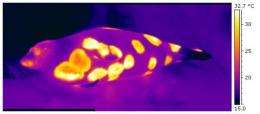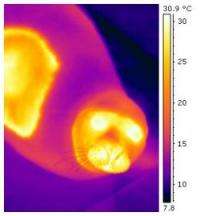Seals like it hot

(PhysOrg.com) -- Using innovative thermal imaging techniques and CCTV recording, a St Andrews academic has shed new light on previously unseen aspects of the life of seals.
Harbour seals, like most mammals, re-grow some or all of their hair each year. In a unique study, William Paterson of the Sea Mammal Research Unit (SMRU) at the University of St Andrews followed two adult female seals from late pregnancy through pupping and then to the end of the moult period.
He used thermal imaging technology to further study the energy this costs the animals, and the impact of the often undetected annual moulting process.
Presenting his results at the British Ecological Society's Annual Meeting at the University of Hertfordshire this week, Paterson reveals a stunning series of thermal images of harbour seals that show graphically for the first time the significant amount of energy these animals expend during their annual moult from August through September.
A joint team from the Sea Mammal Research Unit, University of Glasgow and Edinburgh Napier University used the technology for the first time to measure the body surface temperature of two adult harbour seals as they hauled out of the water onto land.
The images show that their skin heats up to aid the shedding and re-growth of hair, and CCTV footage of the seals shows that they spend more time out of the water during moulting to avoid losing too much heat.
Paterson explains, "Our thermal images show that when moulting, their skin surface gets very hot as they must circulate blood close to the skin surface to allow hair to grow quickly. As a result, they expend a lot of energy during the moult and need to remain ashore for long periods to avoid becoming chilled in the cold water."

"Most mammals, including humans re-grow some or all of their hair each year. We may be familiar with dogs and cats shedding their hair each summer or horses growing a thick coat for the winter. For marine mammals such as seals this annual moult often goes undetected, but it is equally important for maintaining their health and condition while at sea. Growing new hair doesn't come for free as the energy cost of moult for some species of seals is up to half of the energy required to rear a pup."
Paterson's results give insights into the energy requirements of this species, some of whose UK populations have declined by up 50% since 2000, and Paterson hopes that his study could also have positive implications for seal population monitoring.
"Currently, harbour seals are counted by SMRU in aerial surveys during the period of moult. Our study confirms that using thermal imaging to count seals at moult is the most effective way of detecting seals at this time," Paterson continued.
"The work also highlights the importance of the moult period for harbour seals to maintain healthy skin conditions and for body insulation while on land. Emphasis is given to try and not disturb harbour seals during the pupping period as mothers suckle their young, and the same treatment should also be afforded to these animals during the moult period. Disturbances would increase the seals' energy expenditureand prolong the duration of the moult. The implications would be that there would be less time available for foraging as the animals head into winter and they may have less fat reserves as a result."
Provided by Universities of St Andrews

















